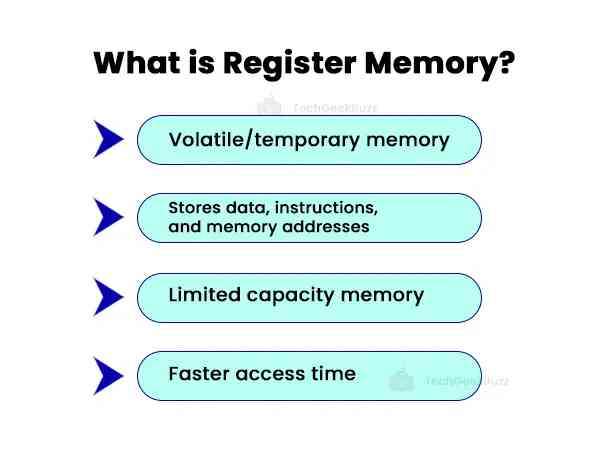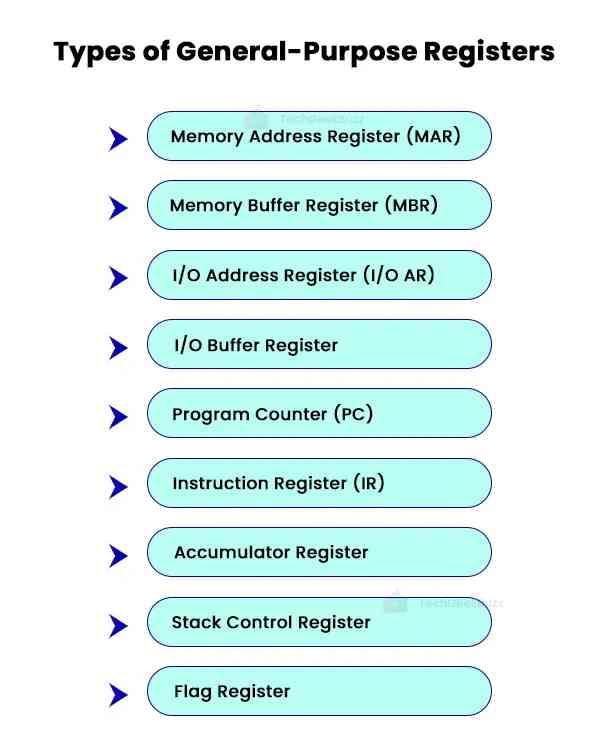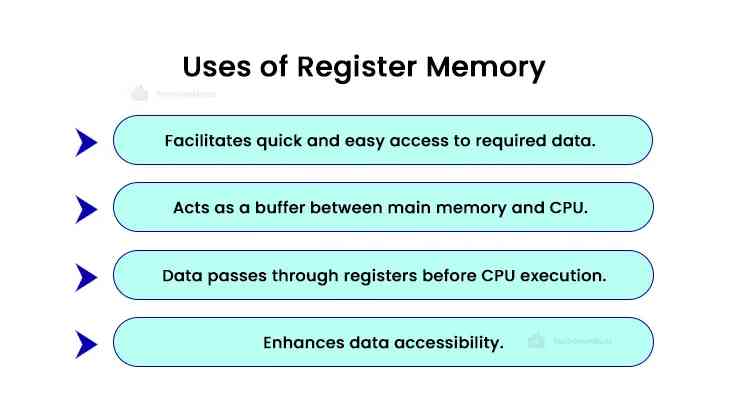When we talk about computer memory, we generally think of RAM or Random Access memory. Random Access Memory is a computer’s primary memory or main memory. It is known for its faster access time. Another memory type that is faster than the main memory is register memory .
Register memory is a computer’s smallest and fastest memory. It resides inside a computer‘s CPU and is in the form of registers. A register, or processor register, is a small data holding place.
This blog post aims to enlighten you on register memory and its different types.
So, let us begin without any further ado!
What is Register Memory?

Register memory is a type of memory that has a very limited capacity. It stores data, instructions, and memory addresses a CPU uses to perform ongoing operations. It is a volatile memory or temporary memory losing all its content once the computer disconnects from the power supply.
All data and instructions that need to be processed by the CPU have to pass through register memory. This memory is not part of the main memory. It is located inside the processor. Hence, it becomes easy and quick for the processor to access data, instructions, and memory addresses stored in this memory.
Register memory is capable of holding only 32 bits to 64 bits of information. The speed depends on the number of registers used and their size.
Some processors have 8 registers, while others have 16, 32, or more. Earlier, registers were 32 bits. However, modern computers with a 64-bit processor have 64-bit registers. These registers can access and store 64-bit memory addresses.
Why is Register Memory Essential?
Register memory is the topmost memory or level-0 memory in the memory hierarchy . This is because it has a faster access time than any other memory in the hierarchy. It stores data or instructions that a CPU needs while executing ongoing processes.
As registers are located inside the CPU, data or instructions are quickly accessed, reducing the delay in task execution. This results in faster execution of tasks and improves the overall performance of a computer.
Types of CPU Registers

Typically, there are four categories of CPU registers - general-purpose, segment, index, and status & control registers.
Let us discuss each type of register in detail below.
1. General-Purpose Registers
General-purpose registers are further categorized into multiple types. Each register has its own characteristics and role in task execution.
The following are the general-purpose registers in the CPU:

-
Memory Address Register (MAR)
MAR stores the address of the memory (memory location) from where the CPU wants to read or write data. This means whenever the CPU wants to read or write data to memory, it stores the address of the desired memory location in the Memory Address Register (MAR).
-
Memory Buffer Register (MBR)
MBR stores the data being transferred to and from immediate access storage. It holds the copy of the value present in the memory location specified by the memory address register (MAR). MBR is also referred to as a memory data register (MDR).
When a particular data item is ready to use for the next clock cycle, it is copied in MBR. Later, the processor uses it for reading or writing. After being written by the processor, the data is then transmitted to the main memory.
-
I/O Address Register (I/O AR)
This register specifies the address of a specific I/O device.
-
I/O Buffer Register
The I/O buffer register is used to exchange data between the I/O module and the processor.
-
Program Counter (PC)
The program counter (PC) is a type of register in the processor that stores the memory address of the next instruction to be executed. It is also referred to as an instruction counter or instruction address register that helps in the faster execution of tasks and keeps track of the current execution point.
When the processor fetches a specific instruction, the program counter increases the IP address by one, pointing to the address of the next instruction to be fetched.
-
Instruction Register (IR)
The instruction register (IR), or current instruction register, is a type of register in the control unit that holds the instruction currently being executed by the processor.
Every instruction to be executed by the processor is loaded into the instruction register from the main memory. IR holds the instruction till the processor decodes, prepares, and ultimately executes it. This takes place in multiple steps.
-
Accumulator Register
An accumulator is a type of register that stores arithmetic and logic data for a short time period. It resides inside the arithmetic logic unit (ALU). The control unit fetches instructions from the main memory and stores them in the accumulator register for arithmetic and logical operations.
The accumulator register can hold the initial data on which operations are to be performed, the intermediate results of operations, and the final result. The final result is transferred to the main memory through MBR.
-
Stack Control Register
A set of memory blocks represents a stack. The data present in these memory blocks are stored and retrieved in the First In, Last Out (FILO) order. The stack control register handles all stacks in memory. The size of this register is 2 or 4 bytes.
-
Flag Register
The flag register is used to indicate certain occurrences during the ongoing operations performed by the CPU. It is a special-purpose register with a size of 1 or 2 bytes. Each bit of this register has a flag or an alert indicating a specific condition during instruction execution.
2. Segment Registers
Before we move on to segment registers, it is important to understand segmentation. Segmentation is the process of logically dividing a computer’s main memory into different segments. Each segment has its own base address. Segmentation aims to accelerate instruction execution by enabling the processor to efficiently and quickly fetch data from the memory.
The segment register stores the starting address of these segments, called the segment address. The Bus Interface Unit (BUI) consists of four 16-bit registers called segment registers. They are as follows:
- Code Segment (CS) Register: This register addresses the memory location in the code segment of the memory. The code segment stores a program to be executed.
- Data Segment (DS) Registers: This register points to the data segment of the memory that stores data.
- Extra Segment (ES) Registers: It is an additional segment in the memory, which is referred to as a data segment.
- Stack Segment (SS) Registers: This register addresses the stack segment in the memory. The stack segment stores the stack data.
3. Index Registers
The index register holds the value, which you can use as an index or offset in memory addressing calculations. This register is useful when you want to access data from the memory with an offset. It ensures efficient memory access and manipulation.
Furthermore, an index register points to operand addresses during the execution of a program . It comes in handy for skipping arrays and strings and holding counters and loop iterations.
4. Status and Control Registers
The status and control register in the processor stores additional information about the results of instruction execution. It holds multiple independent flags, such as carry, overflow, and zero. It is primarily used to determine the output of conditional branch instructions.
The Architecture of Register Memory

From the above image, you can see that registers reside inside the CPU, along with the control unit and ALU. A single operation has two operands, where one is located inside the main memory and the other in a register. If both operands reside in a register, it is referred to as register plus memory architecture .
Three primary functions of registers are fetch, decode, and execute instructions.
- The control unit of the processor fetches an instruction from the main memory and stores it in the instruction register.
- Further, it decodes the instruction to detect the option to be performed and determines the registers involved.
- The control unit then issues control signals to select appropriate registers and transmits the data to ALU.
- The arithmetic logic unit performs operations on the selected register data.
- Based on the control unit’s control signals, the result of the operation is again stored in the register.
Uses of Register Memory
Let us have a look at some of the major uses of register memory.

- The register memory stores the most frequently used data, instructions, and memory addresses. It enables the processes to access the required data quickly and easily. Every data passes through the register memory before going to the processor for execution.
- Registers serve as buffers for holding data from the main memory, making it quickly accessible for the CPU. When the data is stored in a register, it knows the data’s location and address, which is useful for determining the IP address .
- The base register is capable of modifying the operands or operations.
- Registers enable faster data storage, retrieval, and transmission.
Conclusion
This was all about register memory. It is the smallest and fastest of all memory types in the memory hierarchy. As it resides inside the processor, the data register memory holds is easily accessible to the processor. This results in faster instruction execution and improves the system's overall performance.
We have mentioned all the different types of registers and their functions. Hopefully, you might have understood the architecture of register memory and its function and architecture.
If you have any questions, feel free to share them in the comments.
People are also reading:


![What is an Assembler? [Definition, Working, & Types]](/media/new_post_images/What_is_Assembler.jpg)
![What is I/O? [Types, Examples, & Methods]](/media/new_post_images/What_is_I_O.webp)

Leave a Comment on this Post